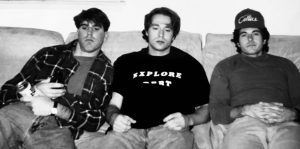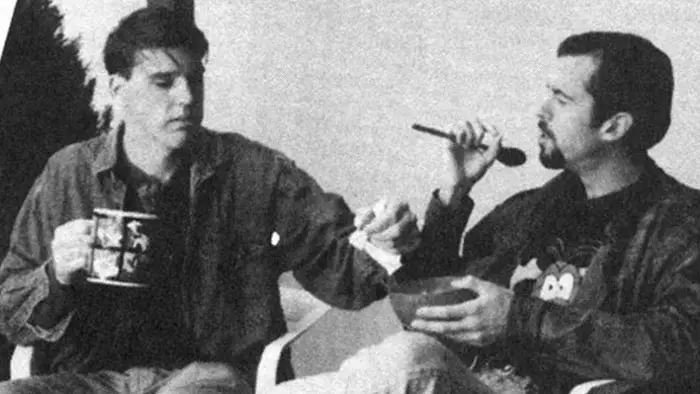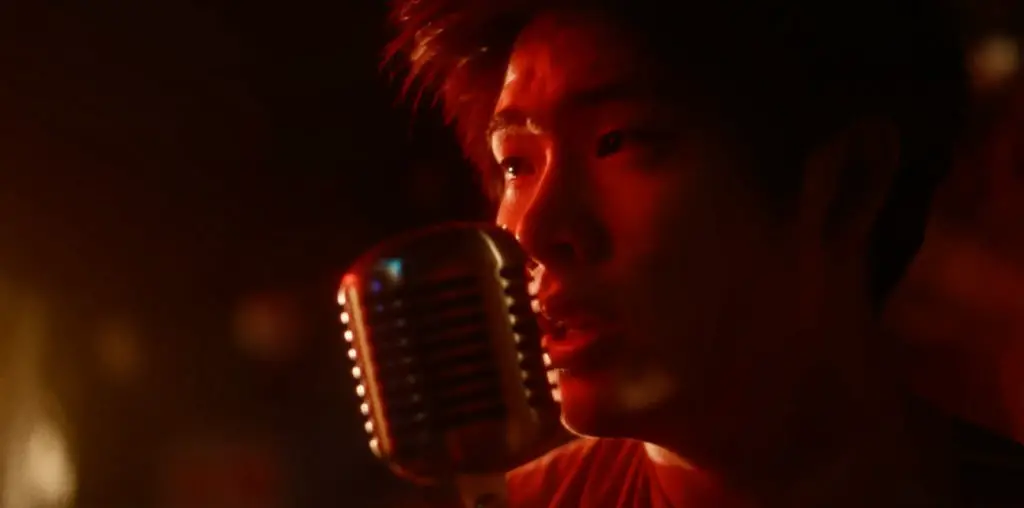
Writer/director goes the Clerks route in the new comedy NoHo, a satiric look at North Hollywood. (Originally published in Film Threat, Issue #27 – April 1996)
“It’s a lot like my life, unfortunately,” deadpan David Schrader, the writer/director/star of the hysterically funny 16mm NoHo. The title is a nickname given to a suburb of Los Angeles called North Hollywood, although its traits aren’t exclusive to L.A.
Quinn (Schrader) and Harvey (Steve Marcia) are two unemployed roommates who are finding it hard to make ends meet in their day-to-day existence. Harvey is content to sit at home alone, drink malt liquor, and watch infomercials. Quinn, on the other hand, is trying to find a job and a woman, but to no avail. Things do take an upturn when Harvey gets accepted as a guinea pig in a depression clinic, and Quinn gets a job working for a producer. But, their euphoria is short-lived when Harvey’s fake depression is found out, and Quinn soon realizes his boss is a sexist, fascist, slave-driving prick. Quinn is left with no other option but to steal his boss’s Jaguar and spend the money on his new girlfriend.

NoHo writer/director David Schrader with Co-Star Steve Marcia
The 24-year-old Schrader was working for Sam Raimi’s company, Renaissance, as a runner in the summer of ’94 when he conceived the film. “I felt like for every step forward I took in this business, I was slipping two steps back, so I decided to go out and make my own film.” A former stand-up comedian, he wen about financing the film by first applying for all the credit cards he could. When he had what he figured was enough money, he turned to his producer/friend Tony Sommers and said, “Let’s just do it.” He utilized 20 locations and 50 speaking parts and put the film in the can in under 10 days for $10,000. On the last day of production alone, they shot 15 pages of the script. To help keep costs of the film to a minimum, he borrowed his cousin’s Jaguar and boat. But perhaps the most ingenious cost-control stunt involved the acquisition of the film stock. Schrader laughs when he remembers the story. “There’s this rental/sales house in North Hollywood called Steadisystem that used to give you 400 feet of film for testing if you were making a feature. All you had to do was bring your script and show them. I had 20 of my friends go in with fake scripts and get the stock. I personally used five different disguises.
With his film in the can and a couple of successful video screening under his belt, Schrader headed to New York’s IFFM (Independent Feature Film Market) late last year to try and drum up support and financing to help them gather enough money to finish post and purchase an answer print, so they could screen it at festivals.
Although the screening was sold out and many studios expressed an interest, Sommers and Schrader still don’t have a confirmed sale.

Illustration by Louisa Esposito.
“New Line said it didn’t cost enough,” laments a frustrated Schrader. “We couldn’t spend a million dollars on this movie if we tried.”
Adds Sommers, “Susan Glatzer was the person at October who asked for it. But she wanted us to recut it at our own expense before she’d bring it to her supervisor. And we don’t have the money.” Indie guru John Pierson received a copy but was busy writing his book and couldn’t commit in any fashion. Amy Israel at Miramax also expressed an interest, but it’s far there’s nothing definite with any of them.
However, the filmmakers do have at least one firm offer on the table. A new company in New York called Millennium Films has offered to pay $10,000 (the cost of production), but they want worldwide theatrical and video rights. In essence, this would mean the filmmakers would give up virtually all future profits from the film just to screen it at festivals.
At press time, Sommers and Schrader were still considering their options. What would you do? Call them at (***) ***-****.
NoHo is celebrating its 25th anniversary with a special Silver Edition now available on Amazon Prime. To commemorate this special anniversary, we had a chance to catch up with NoHo writer/director/star David Schrader.
When we last left off, you had interest from several companies wanting to release NoHo. What was its ultimate fate?
Obscurity, nestled in the footnotes of 90’s indie nostalgia. We had a very successful screening at the IFFM, with meetings from a lot of established independent companies at the time—Miramax, New Line, October Films, and NoHo was being called “The next Clerks.” We ended up with a less than optimum deal, and it had a limited two-weekend run at the Laemmle Sunset 5 in early 1996, which technically made us eligible for the Oscars. Shockingly, no nominations.
Can you describe the film’s journey since then?
I was basically a kid when we made it, and besides having a few student shorts under my belt, had no idea how to make a feature film. I moved on to other projects, co-writing and acting in Sea of Souls, the first film from John Chester, now a great documentarian who made last year’s amazing The Biggest Little Farm. Then I made Being Ozzy Osbourne with Christy Stratton Mann, sold a few pitches, co-wrote and directed an indie horror from Lionsgate called Bloodline, and basically left NoHo in the rearview mirror. Aesthetically, it wasn’t something to hang your hat on, but when I recently revisited it, I thought it was really funny. It contained similar themes to the ones I still explore—questioning authority and status quo, using absurdity to satirize societal shortcomings, both big and small. It’s been unavailable for twenty-five years, so it’s actually a surreal little mid-90’s time capsule and something I wanted to bookend with my upcoming (probably final) feature, Mary Tyler, Millennial.
“…which technically made us eligible for the Oscars. Shockingly, no nominations.”
What would you do differently if you had $10,000 today to make NoHo?
That’s the thing, back then—it was on film. We had a Panavision Elaine 16mm camera and had to use 400 ft. film end “recans” to shoot. We didn’t have a big budget like Clerks. I’m joking, but really, we had a third of Kevin Smith’s budget, and with twenty locations, fifty speaking parts, and ten days to shoot. All things you shouldn’t do when making a micro-budget short, let alone a feature. Our ambition outstripped common sense, but that was a very specific, special time for indie filmmakers. I don’t think you could make NoHo like that on 10K today. I’d like to see someone try though.
What was so exciting and challenging about making NoHo in 1995? Do you miss that style of filmmaking?
Ah, the beauty and the terror of shooting and editing actual filmstock. It had to be done that way; otherwise, it wasn’t considered a “film.” Everything that went into that process was exhilarating, but also scary. We were limited in how many takes we could shoot. Jessica Landaw was our editor, and I think she did a great job, especially given what she had to work with. Tony Summers was our main producer and the hustle to cast, to secure locations and permits, to move even a small crew all around town in such a short time, it was insane, but also some of the best times of our lives. I still make many of my short films in the same way—I’m fortunate to know a lot of talented actors and creatives who are willing to go guerrilla. Mary Tyler’s Millennial was shot in a similar fashion, an unsettling comedy-horror feature shot over one weekend, and with half the budget of NoHo, it has an incredible, female-forward cast, including two big comedy up and comers, Mary Ryan and Lucy Blehar. We didn’t have as many locations, but it was definitely a flashback to those earlier days and that, “Hey kids, let’s put on a show” mentality. But I’m a little older these days, so it just about killed me. It was my micro-budget Apocalypse Now.
“I’ve embraced the very rough edges…”
Tell me about the NoHo: Silver 25th Anniversary B&W Edition?
Let’s face it. The film never looked all that great. Besides Film Threat’s kind words, one of my other favorite reviews was when the L.A. Weekly said it looked “like porn without the sex.” So, since it’s the 25th Silver Anniversary of the movie, my brother had suggested we strip it down to a gloriously grainy black and white and call it NoHo Silver. I’ve embraced the very rough edges—it’s a film from 1995 that looks like it’s from 1925 or some kind of French New Wave Three Stooges mash-up. To paraphrase Bono, “I don’t know what it is, so it must be art.”
Where can we get a hold of the original and the anniversary version?
NoHo Silver is set to premiere on Amazon Prime Video this week or next– I don’t know, these giant corporations have us all by the balls. Sometime after that, we may offer it up on Vimeo and then release a B.D. and DVD with a bunch of extras. The original is lost to history and probably sitting in a giant government warehouse next to the Ark of the Covenant. But if you like Slacker, Clerks, Swingers, or offbeat comedies in general, maybe give NoHo a chance on Prime. Look, it’s new if it’s new to you.



Great review by Film Threat. They were great to us in ‘95 and are still great. Even if they spelled mine and Steve Marca’s name wrong. We love them.